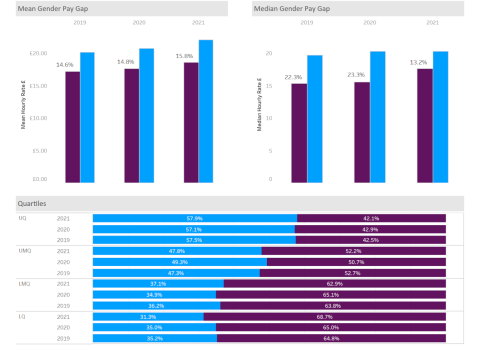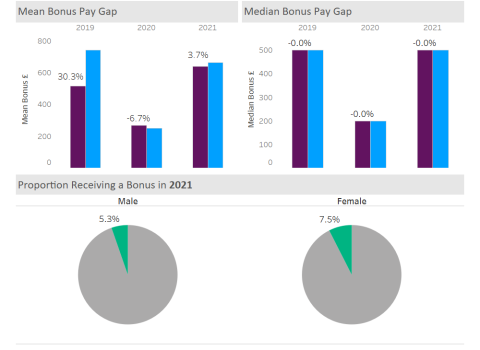University of Portsmouth gender pay gap figures
The gender pay gap shows the difference between the average (mean and median) earnings of males and females and is expressed as a percentage of male’s earnings.
A gender pay gap above zero will show that, on average, males earn more. Complying with statutory calculations, the University has identified its gender pay gap in relation to the:
- mean and median difference between hourly rates for males and females
- the mean and median difference between bonus pay for males and females
- the proportions of male and female employees who were paid bonus pay
- the proportions of male and female employees in each pay band quartile
Mean and median pay gap
The mean pay gap is the difference between the average hourly rate of pay between males and females. The University’s mean pay gap is 15.8% which is higher than the wider economy in England for 2020 (13.9%) and broadly comparable with the pay gap within the HE sector Universities falling within the income bracket of £202m-£400m for 2019 (15.2%). This is a 1.0% increase in the pay gap compared with the previous year (14.8%).
The median pay gap is the difference between the middle point of average hourly rates (when listed in numerical order) of pay for males compared to the middle point of average hourly rates of pay for females. The University’s median pay gap is 13.2% which is lower than the wider economy in England for 2020 (14.9%) and lower than the HE sector Universities falling within the income bracket of £202m-£400m for 2019 (13.7%). This represents a 10.1% decrease when compared with the previous year (23.3%). This is largely due to the decrease in the proportion of staff at the lower grades within the University’s pay structure.
Hourly Pay Gap between Males (blue) and Females (purple)

Mean Gender Pay Gap
- 2019: Mean hourly rate for males is 14.6% higher than for females
- 2020: Mean hourly rate for males is 14.8% higher than for females
- 2021: Mean hourly rate for males is 15.6% higher than for females
Median Gender Pay Gap
- 2019: Median hourly rate for males is 22.3% higher than for females
- 2020: Median hourly rate for males is 23.3% higher than for females
- 2021: Median hourly rate for males is 13.2% higher than for females
Quartiles
Upper quartile
- 2019: Males 57.5%, Females 42.5%
- 2020: Males 57.1%, Females 42.9%
- 2021: Males 57.9%, Females 42.1%
Upper middle quartile
- 2019: Males 47.3%, Females 52.7%
- 2020: Males 49.3%, Females 50.7%
- 2021: Males 47.8%, Females 52.2%
Lower middle quartile
- 2019: Males 36.2%, Females 64.8%
- 2020: Males 34.9%, Females 65.1%
- 2021: Males 37.1%, Females 62.9%
Lower quartile
- 2019: Males 35.2%, Females 64.8%
- 2020: Males 35.0%, Females 65.0%
- 2021: Males 31.3%, Females 68.7%
Gender bonus gap
In the reporting period covered by this report, bonuses paid within the University are paid via Recognition Awards to individuals and teams who have made a significant contribution to the University.
The mean bonus gender pay gap shows the difference between the average bonus pay received by male and female staff. The University’s mean gender bonus gap increased to 3.7%, from -6.7% reported in the previous year. This increase is largely because there was an all staff recognition payment awarded in 2020, which was received by a higher proportion of females to males, due to the demographics of the university’s workforce.
The average bonus received by females in 2021 was £640, compared to males who received an average bonus of £664.
The median bonus gender pay gap for University staff has remained at 0%, which is consistent with previous years.
Proportion of male and female colleagues receiving a bonus
The proportion of colleagues across the University who received a bonus under the statutory definition was 7.5% of females receiving a bonus and 5.3% of males receiving a bonus. This shows that a higher proportion of females are receiving bonuses to males but more females are employed to males (56% of staff at the reporting date are female).
Proportion of male and female colleagues in each pay quartile
The University has identified the percentage of female and male colleagues in each of four pay quartiles, by dividing the workforce into four equal parts.
Female colleagues account for 68.8% of the lowest quartile which has increased from the previous year (65%) and 62.7% the lower middle quartile which has decreased from the previous year (65.1%).
The upper middle quartile is more balanced with female colleagues making up 52.2% of this population compared with 50.7% in the previous year.
In the upper quartile, the split between female and male is 42.1% female and 57.9% male, which remains similar as the previous year.
Hourly Bonus Pay Gap between Males (blue) and Females (purple)

Mean Bonus Pay Gap
- 2019: Mean bonus pay for males is 30.3% higher than for females
- 2020: Mean bonus pay for males is 6.7% lower than for females
- 2021: Mean bonus pay for males is 3.7% higher than for females
Median Bonus Pay Gap
- 2019: Median bonus pay for males is the same as for females
- 2020: Median bonus pay for males is the same as for females
- 2021: Median bonus pay for males is the same as for females
Proportion receiving a bonus in 2021
- Male: 5.3%
- Female: 7.5%
Why we have a gender pay gap
Another contributing factor to the University’s pay gap is the higher proportion of males in more senior academic roles, with 29.3% of professors being female (29 out of 128 as at snapshot date). This is not only a concern for the University but a wider known issue across the Higher Education sector.
A way to decrease the gender pay gap would be to increase the numbers of females in leadership positions across the University, particularly in academic roles, and also to ensure that roles at all levels across the University attract a diverse pool of applicants.
The University recognises that many challenges remain and is determined to take action to ensure that our day-to-day practice reflects the quality of our policy commitments.
How we're addressing the gender pay gap
Equality, Diversity and inclusion is integral to the University’s Strategy. The University is committed to deliver against its ambitions as outlined in this Strategy with clear actions being identified as part of the University’s Equality, Diversity and Inclusion Framework and its Athena Swan Action Plan.
The University is very proud to have achieved a Bronze Award for the Equality Challenge Unit (ECU) Athena SWAN Charter, in recognition for work undertaken to address gender equality across the University.
Statement
In order to comply with The Equality Act 2010 (Gender Pay Gap Information) Regulations 2017, the University is required to publish gender pay gap information every year for all staff employed on 31 March each year.
Equality, diversity and inclusion underpins all our work and is at the heart of what we are and what we do. Our commitment is not restricted to the minimum legal requirements of equalities legislation, as we aim to deliver best practice whenever possible.
The University of Portsmouth is a diverse, multicultural and international community, committed to working in an inclusive way, developing a workforce that reflects our student community, the City of Portsmouth and the region’s diversity.
We are determined to identify and remove any potential gender bias and to ensure that we have an inclusive culture that values all staff.
The data published in this report is accurate and satisfies the requirements of the Equality Act 2010 (Gender Pay Gap Information) Regulations 2017.
